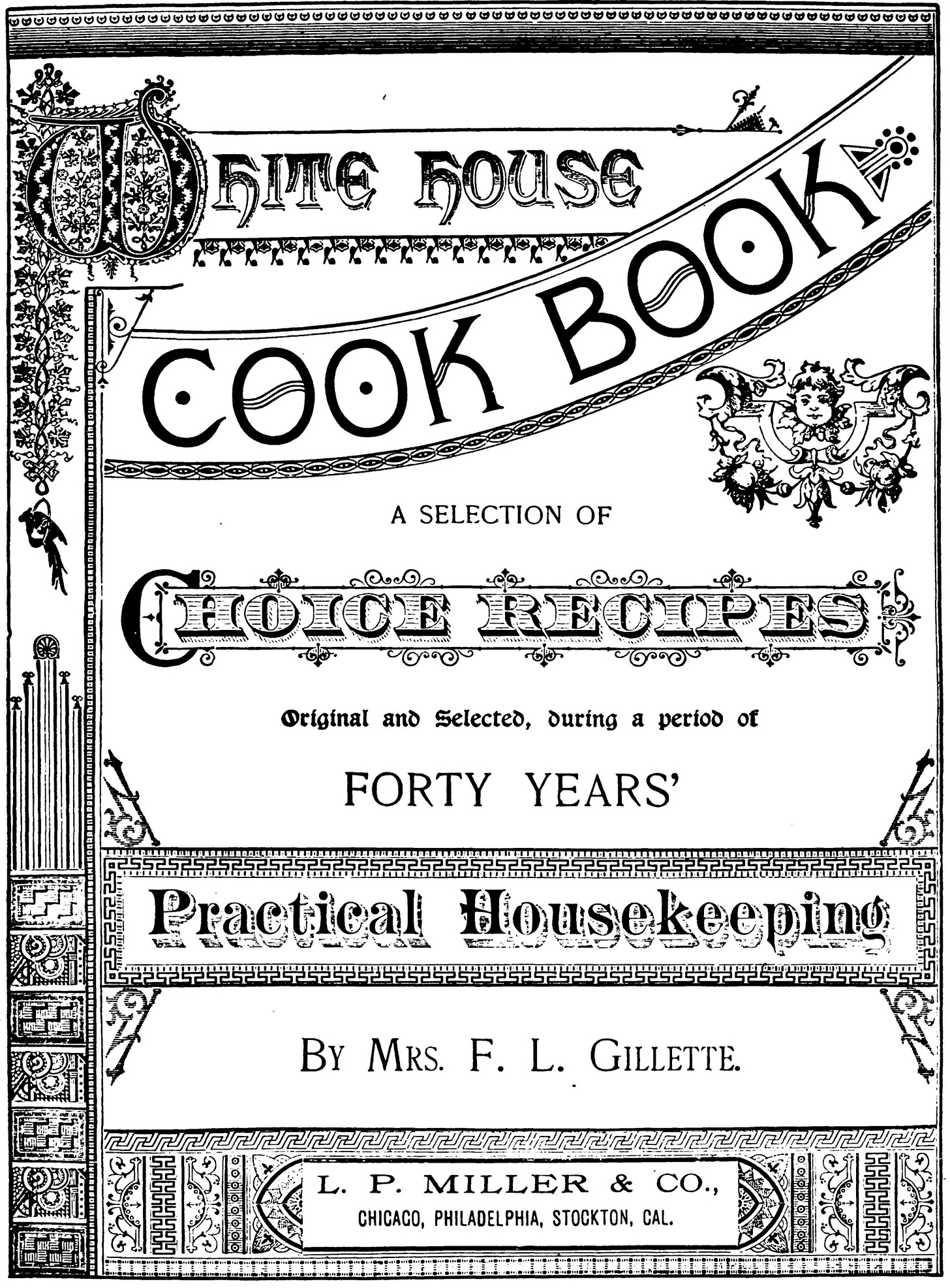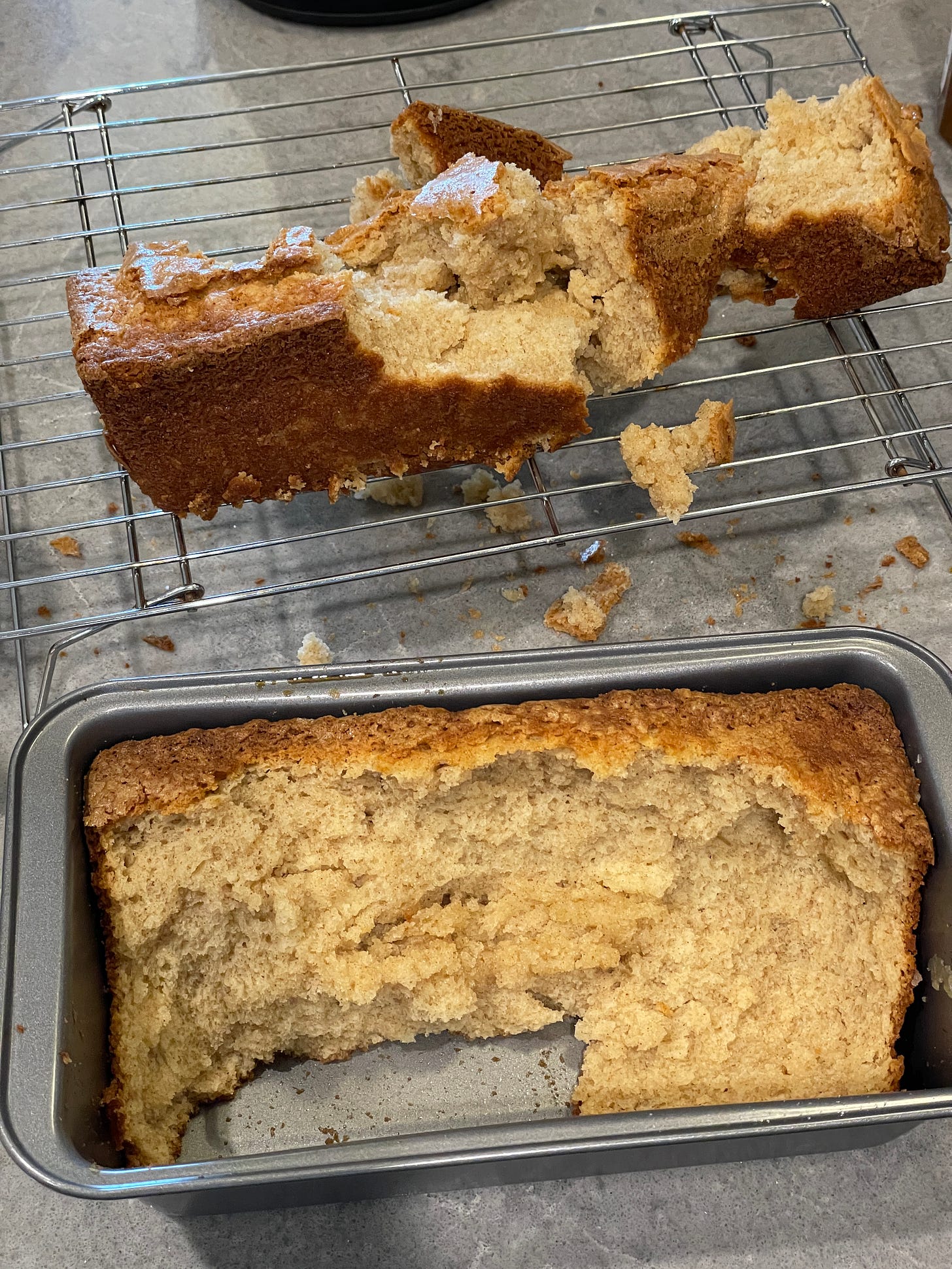Right now seems like a grim time to make a recipe from, or talk about, The White House Cook Book, given the even more grim reality of the current White House, but, in the words of Margaret Atwood, “nolite te bastardes carborundorum.” Don’t let the bastards grind you down.
The cookbook was first published in 1887 by Fanny Lemira Gillette, and, despite its name and the dedication to the First Ladies, no First Lady, past or current at the time of the book’s publishing, was involved in the creation of the book. In fact, there is nothing in the book that relates to the White House other than some photos of various first Ladies. In modern terms, the title of the book is nothing more than clickbait. Some things are older than we think.
In later editions, Hugo Ziemann, the steward of the White House, was a contributor. But, again, nothing much relating to the White House appears in those editions either aside from some banquet menus and what amounts to two pages on the management of state dinners at the presidential home. Given that the cookbook was marketed as a household manual and guide to practical housekeeping, it’s difficult to understand how the etiquette of White House receptions would have been helpful to the women who bought it.
As a steward, Ziemann would not have necessarily had any in-depth knowledge of White House cookery. His job involved greeting guests and anyone arriving to see the president between 1880 and 1891. This is likely why in a cookbook his contribution was not in recipes or actual meals served but with etiquette and management of things like seating arrangements and order of service.
Aside from his gig at the White House, Ziemann seems to have had a long resume of prestigious appointments, including, according to the Publisher’s Preface, caterer to “that Prince Napoleon.” This refers to Napoleon Bonaparte’s grandson Napoleon Eugene Louis Jean Joseph Bonaparte, also known as the Prince Imperial. Why have just one or two names when you can have five?
Gillette, for her part, was a prolific cookbook author who found success later in life. She was 60 years old at the publication of the first edition of The White House Cook Book. Riding the wave of the success of this book, she went on to publish several more cookbooks before her death at the age of 98.
The cookbook itself became very popular, despite the misleading title. By the beginning of the 20th century, it had become a popular gift to give newlywed women. It went on to have several more editions and updates, with the latest one being in 1996. This edition was released in time for the presidential election that year. This time, the book’s blurb claimed to actually be a product of the White House. Furthermore, it made it sound like it had originally been a White House creation. This edition was, according to the back cover, ‘the most tasteful text to come out of the White House in the last 100 years.” And yet, they demonized the original edition of the book for being full of cream, eggs, salt, taking too long to cook, etc. This was a product of the time, the blurb acknowledges, a time when “obesity was considered a sign of good living.”


The book’s shtick, predictably, was recipes updated to be quick, low-fat, no-fat, and “healthier.” This, of course, was also a product of the time. The 1990s was ripe with fat-hating diet rhetoric that has been proven to be false – fat isn’t inherently bad – and damaging in the long term. There even was a “War on Fat” campaign that aimed to get Americans to reduce fat consumption for healthier living. What it did was create an increase in carbs and sugar consumption that fueled the obesity epidemic. We are, collectively, still dealing with the consequences.
Unlike previous editions of the book, the 1996 one did include recipes by White House occupants. Hilary Clinton and Barbara Bush contributed recipes. Clinton’s recipe was a chocolate chip cookie and Bush’s scotch shortbread. Rather than being integrated into the book’s sections for various courses and types of foods, the recipes by the first ladies lead, appearing just after the introduction. The remaining recipes are a selection from the ones in the Gillette-Ziemann edition. They all include nutritional information and are formatted in the style of modern recipes.
Going back to the original book, there are many that I would love to try, but given that today is the 2nd anniversary of this publication, cake seemed like a good idea, following last year’s trend. Despite the current state of the world, I choose to celebrate the things that feel like accomplishments to me, and two years of showing up is definitely an accomplishment.
Aside from wanting a celebratory cake, I’ve also been wanting to try huckleberries so when I saw a relatively straightforward recipe for huckleberry cake in there, I decided that’s what I was going to make. My current culinary school schedule is bonkers so straightforward is just about all I can manage.
But “straightforward” was a lie. As if to mock me and my efforts to celebrate, the recipe managed to fool me until I was literally starting to mix it. I had softened butter in the mixing bowl, and what seemed like an ungodly amount of sugar. The sugar to butter ratio was so off that, when creaming in a stand mixer, the entire glob of sugar and butter formed a football-shaped mass that just stuck to one side of the paddle. Normally, the paddle spreads the mixture on the sides of the bowl as it creams.
But that wasn’t the biggest problem. The problem, readers, was the flour. I had read the recipe a dozen times, and each time I failed to see that, despite flour being mentioned twice, there was no amount given.
In that moment, I decided that rather than waste my very expensive huckleberries – I had to order them from Washington – I was going to test the cake first to see if it even worked. So, I added two cups of flour to the cake and put it in the oven. An hour later, it was time to take it out. And here the misfortunes continued.
Despite greasing an already nonstick pan, the cake was stuck at the bottom. So, when it came time to remove it from the pan, it just fell apart. And, to my surprise, it was ever so slightly underdone in the center, despite the cake tester coming out clean. I did try some pieces and, as predicted, it was cloyingly sweet. Really, too sweet, even for me, who likes sweet to be really sweet. It is, of course, entirely possible that I am using finer sugar than Gillette was, thus my two cups held more weight of sugar than hers. A case for weighing ingredients if there ever was one, but that is a whole other issue.
Because I didn’t know how much flour Gillette intended to use – it only says to mix the huckleberries with some flour, and that the baking powder should be rubbed with the flour – I had no way of knowing what type of cake this was. I looked at other cake recipes in the book and the omission of flour here was certainly a mistake, but there were no other cakes similar to this one.
This is the point in the recreation and modernizing of historical recipes when you have to make the decision of keeping the integrity of the original recipe, as flawed as this one was, or rework it, adjust ingredients, and make it into a recipe that works and maintains the spirit of the original even if they are not exactly the same (something the writers and editors of the 1996 edition should have considered!). This process of making historical recipes usually isn’t a big problem, except in baked goods. Baked goods will get you.
Even then, I can count with the fingers of one hand the number of times recipes have simply, entirely, and irrevocably flopped, even on the first attempt, like this one. In recent memory, only one comes to mind. It wasn’t a baked good, but it was a dessert. Right after I made Junket with Strawberries, which did not flop at all, I decided to make another junket dessert with condensed milk. That one did not fare well.
I followed a recipe from 1913 that said condensed milk was fine to use for junket. So, I made it. But it didn’t set. Not even slightly. Turns out, that the junket tablets from 1913 were made with animal rennet and the modern tablets are made with vegetable rennet. I would have known modern tablets would not have worked with condensed milk if only I had read the entire junket tablet box. It clearly says that it will not with condensed milk. That failure was entirely on me.
Sometimes the difference between a historical recipe that worked then and doesn’t work now is that ingredients, despite having the same name, change. This is completely out of my control, or your control, and you often don’t know until you have a failure on your hands. There are many reasons why historical recipes may not work today, and you can’t always predict it.
I didn’t share that junket failure on my website (I wasn’t writing on Substack then), but I did share it on Instagram. This time, I hesitated about sharing this cake failure, but, in the end, I decided to do it. Mostly because it is a testament to the hard work that goes into recipe development, whether you are starting from scratch or from historical recipes. This failure also speaks to the fact that for every great recipe you see online, there may be countless attempts that ended in less than desirable products, if not entirely in failure.
I am not trying to cultivate an image of perfection. I wouldn’t trust anyone who actively sought to make themselves seem perfect at what they do. What I am trying to cultivate is an image of perseverance, grit, and always learning. These, to me, are some of the most important qualities a person can have, both in and out the kitchen.
I will keep working on this recipe, but for now, here you have my failures. My failure to notice a missing ingredient. My failure to travel back in time and peep in Fanny Gillette’s kitchen and see if she really used two cups of sugar, how much flour she used, or if she made this recipe at all.








Great post - you had me at Nolite Te Bastardes Carborundorum.
Enjoyed reading about your challenges of playing with historical recipes. I've had similar experiences with a tiny Sicilian cookbook badly translated into English. But I can't get rid of it because I bought it on my honeymoon, so I just try to guess! With varying results.
so interesting!!!